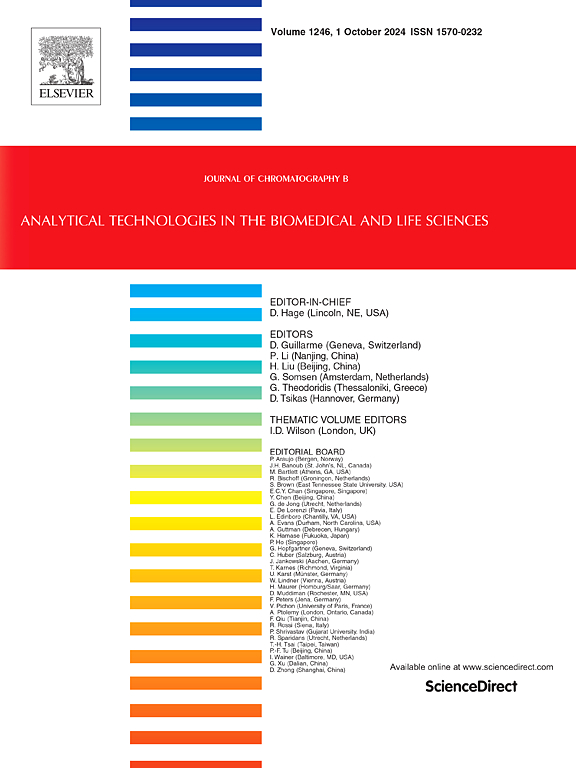Trimethylaminoethyl ester derivatization and stable isotope derivatization for enhanced analysis of fatty acids in biological samples by electrospray ionization tandem mass spectrometry
IF 2.8
3区 医学
Q2 BIOCHEMICAL RESEARCH METHODS
引用次数: 0
Abstract
Background
Abnormal fluctuations in free fatty acids (FFAs) are associated with cardiovascular diseases. However, conducting a thorough analysis of individual FFAs via mass spectrometry has historically posed challenges due to their low ionization efficiency and the absence of distinctive fragment ions.
Results
In this study, we introduce a method utilizing paired stable isotope derivatization coupled with liquid chromatography–triple quadrupole mass spectrometry (ID-LC-QQQ-MS) for thorough identification and relative quantification of fatty acids in serum samples. This method involves the derivatization of the carboxyl groups of FFAs using a pair of isotope reagents, resulting in the formation of FA trimethylaminoethyl ester (FA-TMAE-h3/d3), which can yield two distinct neutral fragments with masses of 59 and 62 Da during collision-induced dissociation (CID). Consequently, a quadruple neutral loss scan (QNLS) approach was utilized for the non-targeted profiling of FFAs in serum samples. The derivative peak pairs displaying matching retention times and distinct mass differences were extracted from the two QNLS spectra and recognized as potential FFAs. Subsequently, a multiple reaction monitoring (MRM) detection protocol was established for the relative quantification of fatty acids in the serum of Syrian Golden Hamsters subjected to various treatments, utilizing a pooled sample labeled with a heavy isotope as an internal standard. Partial least squares discriminant analysis (PLS-DA) revealed notable variations in these 23 fatty acids across the four groups.
Significance
The current stable isotope derivatization (ID) method, in conjunction with tandem mass spectrometry (MS/MS) analysis, stands out as a promising approach for identifying and quantifying FFAs in real samples.

三甲氨基乙基酯衍生化和稳定同位素衍生化用于电喷雾电离串联质谱分析生物样品中的脂肪酸
游离脂肪酸(FFAs)的异常波动与心血管疾病有关。然而,由于其电离效率低且缺乏独特的碎片离子,通过质谱法对单个FFAs进行彻底分析一直存在挑战。结果本研究采用稳定同位素衍生化配对-液相色谱-三重四极杆质谱联用(ID-LC-QQQ-MS)对血清样品中脂肪酸进行了全面鉴定和相对定量。该方法使用一对同位素试剂衍生FFAs的羧基,形成FA三甲氨基乙基酯(FA- tmae -h3/d3),在碰撞诱导解离(CID)过程中可以产生两个不同的中性片段,质量为59和62 Da。因此,四重中性损失扫描(QNLS)方法被用于血清样本中FFAs的非靶向分析。从两个QNLS光谱中提取出具有匹配保留时间和明显质量差的导数峰对,并将其识别为潜在的FFAs。随后,建立了一种多反应监测(MRM)检测方案,利用用重同位素标记的混合样品作为内标,对不同处理的叙利亚金仓鼠血清中的脂肪酸进行相对定量。偏最小二乘判别分析(PLS-DA)显示,这23种脂肪酸在四组之间存在显著差异。当前的稳定同位素衍生化(ID)方法与串联质谱(MS/MS)分析相结合,是鉴定和定量实际样品中游离脂肪酸的一种有前途的方法。
本文章由计算机程序翻译,如有差异,请以英文原文为准。
求助全文
约1分钟内获得全文
求助全文
来源期刊

Journal of Chromatography B
医学-分析化学
CiteScore
5.60
自引率
3.30%
发文量
306
审稿时长
44 days
期刊介绍:
The Journal of Chromatography B publishes papers on developments in separation science relevant to biology and biomedical research including both fundamental advances and applications. Analytical techniques which may be considered include the various facets of chromatography, electrophoresis and related methods, affinity and immunoaffinity-based methodologies, hyphenated and other multi-dimensional techniques, and microanalytical approaches. The journal also considers articles reporting developments in sample preparation, detection techniques including mass spectrometry, and data handling and analysis.
Developments related to preparative separations for the isolation and purification of components of biological systems may be published, including chromatographic and electrophoretic methods, affinity separations, field flow fractionation and other preparative approaches.
Applications to the analysis of biological systems and samples will be considered when the analytical science contains a significant element of novelty, e.g. a new approach to the separation of a compound, novel combination of analytical techniques, or significantly improved analytical performance.
 求助内容:
求助内容: 应助结果提醒方式:
应助结果提醒方式:


